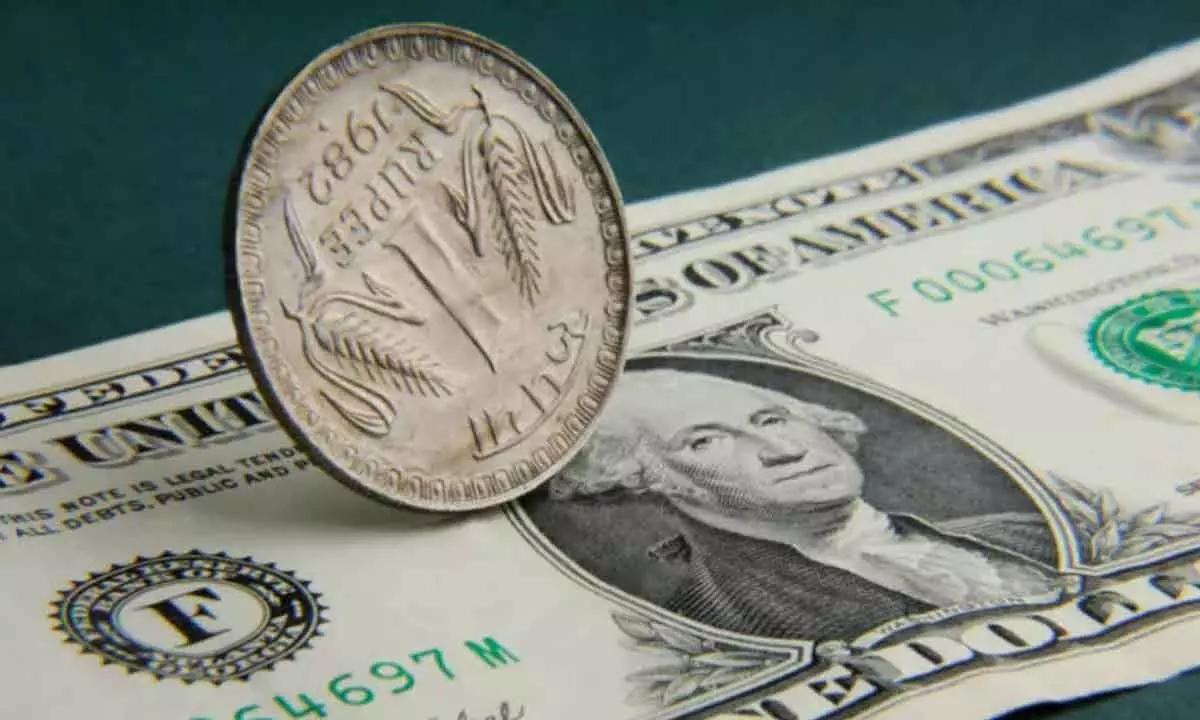Re in consolidation mode as Dollar index correcting
Dollar index declines from 107 mark to 101.5 in last 2 months; Fall in Greenback is expected to continue for a 2nd consecutive week owing to strong expectations that the Federal Reserve will initiate interest rate cuts in 2024
image for illustrative purpose

Stability Prevails
- USD-INR offers medium-term buying opportunity at 83 mark
- Dollar index in year-end correction
- It’s weighed down by Fed rate cut speculation
- Importers and exporters finalize trades in year-end biz
- RBI intervention keeps range amid dollar volatility
Hyderabad: The INR-USD pair recorded 80.95 on January 23 and 83.66 on September 20 this year. The home currency marginally lowered 0.66 per cent to 83.15 as on Friday (December 22) and quoted at 83.23 level, 0.76 per cent lower, on forex platforms on Sunday (Dec 24) as against 82.60 on December 24, 2022. The local unit rose for the first-time last week on Friday as it recovered by 12 paise to 83.15 amid a weak US currency and positive equity market sentiment.
The Dollar-Rupee pair (USDINR) has been consolidating within the range of 83.00 to 83.50 for several months, according to SMC Global Securities Ltd.
Despite the significant volatility in the dollar, USDINR has not moved substantially, partly due to interventions by the Reserve Bank of India (RBI). Given the current levels, trading USDINR in a specific direction is challenging. However, if the weakening trend of the U.S. dollar persists, any correction towards the 83 mark in USDINR could be viewed as a buying opportunity from a medium-term perspective.
“On the charts, the Dollar Index (DXY) is currently approaching a crucial multi-month support zone around the 100.80-101.00 levels. Presently, it hovers just above the oversold territory, with the Relative Strength Index (RSI) situated around the 33-34 mark. Despite being in the last week of the calendar year, a period typically marked by holiday mode, there’s a historical phenomenon where importers and exporters finalize trades, potentially triggering a correction in the dollar,” Tapish Pandey, research analyst at SMC Global Securities Ltd, told Bizz Buzz.
Dollar index fell from 104 to 101.70 in the last 10 sessions. The dollar index has been experiencing a downward trend, sliding from the 107 mark to around 101.5 over the past two months.
“This decline is anticipated to continue for a second consecutive week, influenced by strong expectations that the Federal Reserve will initiate interest rate cuts next year. Recent data revealed that US economic growth in the third quarter wasn’t as robust as previously thought, and there was a marginal increase in the number of Americans filing new claims for unemployment benefits last week,” added Pandey.
While expectations lean towards a correction towards the support zone of 101 or even lower, the index’s proximity to oversold territory suggests limited downside momentum.
“Consequently, it’s anticipated that the DXY may consolidate around the 101 oversold zones in the short term. It’s worth noting that the last week of the calendar year could introduce some volatility, and traders should remain vigilant,” observes Pandey.
Bullion
The declining US dollar and Treasury yields also pushed bullion prices up as gold rose a second consecutive week amid renewed buoyance among traders over rate cut hopes.
Ravinder Kumar, senior research analyst (commodities) at SMC Global Securities Ltd, said: “On the Comex, gold prices rebounded after testing significant support at $1,980 and are now advancing towards $2,080; a break above this level could push prices to new highs. Silver prices are mirroring gold’s trajectory and may trade in the range of $23.600 to $25.90. Looking ahead in the week, Gold prices on MCX are expected to fluctuate between Rs61,500 and Rs63,400, while silver may trade in the range of Rs73,200 to Rs77,400.”
“Lower interest rates reduce the opportunity cost of holding non-yielding bullion. Meanwhile, UK inflation plummeted in November to a more than two-year low, reinforcing the possibility of a global cycle of rate cuts. In other regions, the Bank of Japan maintained its ultra-loose monetary policy, and the People’s Bank of China kept benchmark lending rates unchanged,” further added Kumar.

